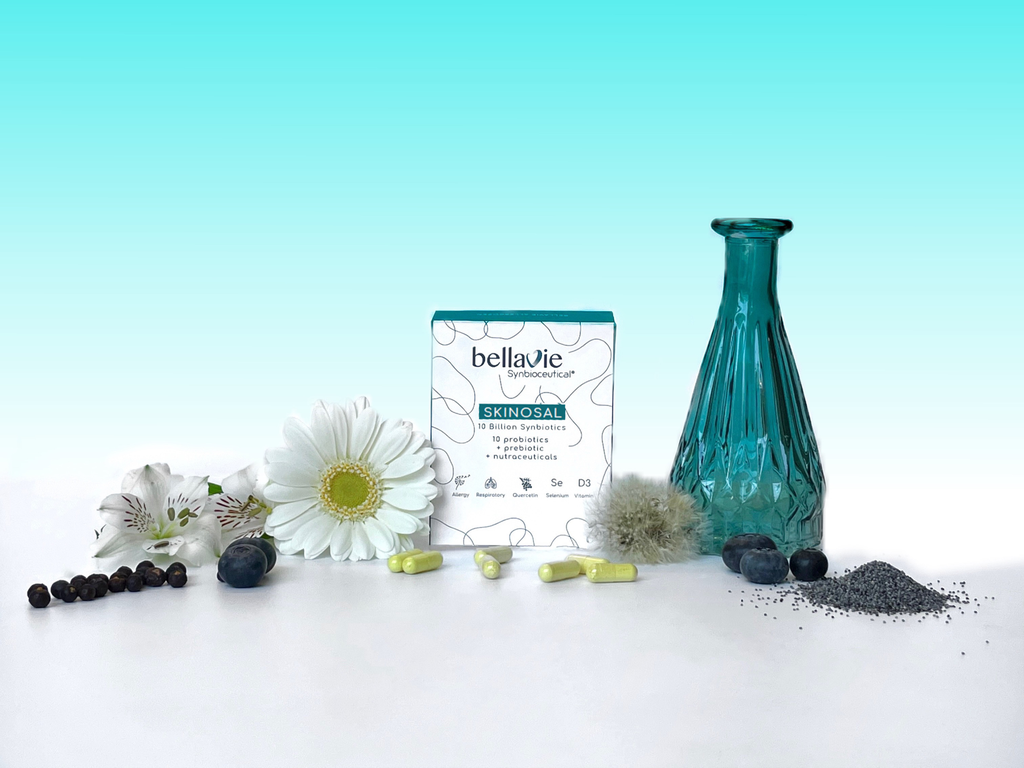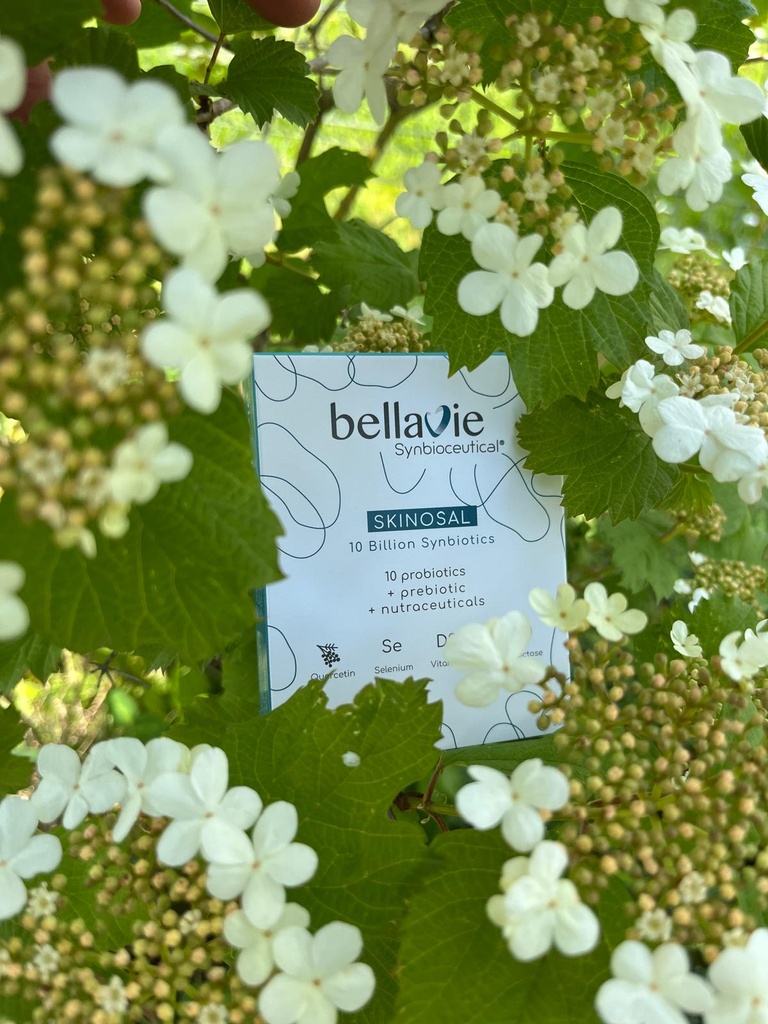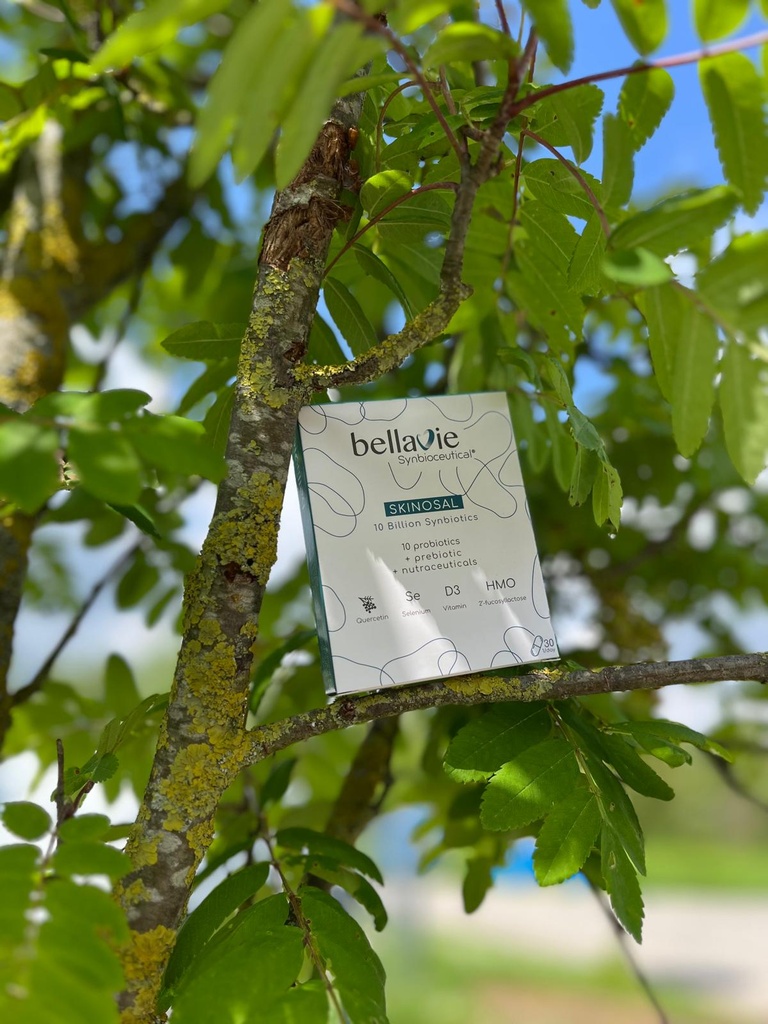- Tous les produits
- BellaVie SKINOSAL
BellaVie SKINOSAL
/shop/bel-07-bellavie-skinosal-384BellaVie SKINOSAL est un complément alimentaire formulé pour soutenir votre équilibre général au quotidien.
Il contient 10 souches probiotiques vivantes, des prébiotiques et des nutraceutiques, tous sélectionnés pour leurs effets bénéfiques reconnus sur la santé.
La formule a été développée avec des bactéries intestinales essentielles pour favoriser l'équilibre du microbiote intestinal.
La formule est complétée par des prébiotiques qui agissent en synergie avec les souches probiotiques et renforcent leur activité.
BellaVie SKINOSAL contient de la quercétine, du sélénium et de la vitamine D3 qui contribuent à l'équilibre normal des th1/th2.
Disponible en boîte de 30 gélules.
Price only available in Europe
Conditions générales
Garantie satisfait ou remboursé de 30 jours
Expédition : 2-3 jours ouvrables
Retrouvez-nous également sur Farmaline !
Coming soon
10 souches de probiotiques
Bacillus coagulans–LMG 6326
Lactobacillus rhamnosus–ATCC 53103
Lactobacillus acidophilus–ARS B-3208
Lactobacillus bulgaricus–CNCM I-5435
Lactobacillus salivarius–LMG 9477
Lactobacillus casei–CNCM I-5094
Streptococcus thermophilus–CNCM I-4912
Bifidobacterium bifidum–CNCM I-5091
Bifidobacterium infantis–LMG 25627
Bifidobacterium breve200BN–CNCM I-5112
Prébiotique
HMO (2'-fucosyllactose) : 30 mg
Nutraceutique
Quercetine >95%
Vitamine D3 = 5 μg/cap (100000 IU/g) / 200 IU parcap = 100%NRV*
Selenium = 55 μg/cap = 100%NRV*(Selenium enriched yeast at 2000 μg/g)
*Nutritional Reference Value
- Fabrication 100% belge
- Souches vivantes : Toutes nos formules ont été développées avec des souches microbiennes, qui sont des bactéries vivantes.
- Formule innovante : la formule a été développée pour des utilisations spécifiques. Le produit contient des souches microbiennes, des fibres et des nutraceutiques bien décrits scientifiquement pour les bienfaits spécifiques pour la santé
- Large spectre: UFC = Unité de Formation de Colonies qui permet d'estimer le nombre de bactéries viables dans un échantillon.
- Haute concentration : chaque capsule contient une grande quantité de micro-organismes vivants. La quantité est indiquée en UFC (Unité de Formation de Colonies). Chaque capsule contient 10.000.000.000 UFC.
- Capsules végétales et certification Halal : les capsules sont certifiées végétaliennes, halal et kasher.
- Capsules gastro-résistantes : pour protéger les souches microbiennes de l'acidité de l'estomac, nous utilisons des capsules spécifiques présentant une résistance supérieure à cette acidité. La quantité de souches microbiennes vivantes dans l'intestin sera donc plus élevée.
- Nutraceutiques spécifiques : les nutraceutiques sont choisis en fonction de l'action souhaitée.
- Souches résistantes à la chaleur: Le Bacillus Coagulans est une souche mondialement connue qui offre une résistance optimale à la température jusqu'à la zone 4B. Cette zone indique un climat très humide et intense.
- Emballage résistant à l'humidité : notre emballage (capsule et blister) à faible teneur en humidité, a été sélectionné pour préserver les souches microbiennes contre l'humidité et leur permettre de vivre plus longtemps.
1 gélule par jour à prendre avec un grand verre d'eau.
Possibilité d'augmenter à 1 capsule 2 fois par jour si besoin ou selon les recommandations.
Les gélules BellaVie peuvent être prises à tout moment de la journée.
Conservez dans un endroit frais et sec.
La réfrigération est recommandée lorsque cela est possible.
Comme les gélules contiennent des micro-organismes vivants séchés, il est recommandé d'éviter les fortes variations de température et d'humidité.
Tenir hors de la portée des enfants.
Aucun effet secondaire indésirable n'a été rapporté.
Précautions : Si vous êtes enceinte, allaitez, avez un problème de santé ou prenez des médicaments sur ordonnance, consultez votre médecin avant d'utiliser ce produit. Non indiqué chez les patients immunodéprimés. Ne pas dépasser la dose journalière indiquée. Ce complément nutritionnel ne remplace pas une alimentation variée, équilibrée et un mode de vie sain.
Ne pas utiliser si d'autres aliments contenant du 2'-fucosyllactose sont consommés le même jour.
Réferences:
1. Aafa.org. 2022. Allergies and Allergic Reactions | AAFA.org | AAFA | Allergies. https://www.aafa.org/allergies.aspx
2. Cleveland Clinic. 2022. Allergies: Types, Symptoms, Causes & Treatments. https://my.clevelandclinic.org/health/diseases/8610-allergy-overview
3. Michail, S., 2009. The role of Probiotics in allergic diseases. Allergy, Asthma & Clinical Immunology, 5(1).
4. Du, X., Wang, L., Wu, S., Yuan, L., Tang, S., Xiang, Y., Qu, X., Liu, H., Qin, X. and Liu, C., 2019. Efficacy of probiotic supplementary therapy for asthma, allergic rhinitis, and wheeze: a meta-analysis of randomized controlled trials. Allergy and Asthma Proceedings, 40(4), pp.250-260.
5. RDN, C., 2022. Probiotics for Asthma: An Update - International Probiotics Association. International Probiotics Association. https://internationalprobiotics.org/asthma/
6. National Eczema Association. 2022. Probiotics: The Search for Bacterial Balance. https://nationaleczema.org/search-bacterial-balance/
7. Jensen, G., Cash, H., Farmer, S. and Keller, D., 2017. Inactivated probiotic <em>Bacillus coagulans</em> GBI-30 induces complex immune activating, anti-inflammatory, and regenerative markers in vitro. Journal of Inflammation Research, Volume 10, pp.107-117.
8. Proquest.com. 2022. ANTI-INFLAMMATORY AND IMMUNOMODULATORY EFFECTS OF BACILLUS COAGULANS UNIQUE IS2 - ProQuest https://www.proquest.com/openview/de2d19fcfbb134900ca10fcaba87f0b7/1?pq-origsite=gscholar&cbl=136102 .
9. 2022. [online] Available at: https://www.karger.com/Article/FullText/515352 .
10. Cukrowska, B., Ceregra, A., Maciorkowska, E., Surowska, B., Zegadło-Mylik, M., Konopka, E., Trojanowska, I., Zakrzewska, M., Bierła, J., Zakrzewski, M., Kanarek, E. and Motyl, I., 2021. The Effectiveness of Probiotic Lactobacillus rhamnosus and Lactobacillus casei Strains in Children with Atopic Dermatitis and Cow’s Milk Protein Allergy: A Multicenter, Randomized, Double Blind, Placebo Controlled Study. Nutrients, 13(4), p.1169. - https://www.ncbi.nlm.nih.gov/pmc/articles/PMC8066586/
11. Wickens, K., Black, P., Stanley, T., Mitchell, E., Barthow, C., Fitzharris, P., Purdie, G. and Crane, J., 2012. A protective effect of L<i>actobacillus rhamnosus</i>HN001 against eczema in the first 2 years of life persists to age 4 years. Clinical & Experimental Allergy, 42(7), pp.1071-1079. - https://pubmed.ncbi.nlm.nih.gov/22702506/
12. Elmadfa, I., Klein, P. and Meyer, A., 2010. Immune-stimulating effects of lactic acid bacteria <i>in vivo</i> and <i>in vitro</i>. Proceedings of the Nutrition Society, 69(3), pp.416-420. - https://www.cambridge.org/core/journals/proceedings-of-the-nutrition-society/article/immunestimulating-effects-of-lactic-acid-bacteria-in-vivo-and-in-vitro/072C2E5023504BFC338584413A3C1AF2
13. Jing, W., Liu, Q. and Wang, W., 2020. <i>Bifidobacterium bifidum</i> TMC3115 ameliorates milk protein allergy in by affecting gut microbiota: A randomized double‐blind control trial. Journal of Food Biochemistry, 44(11). – <No study/No link in the power point>
14. Niers, L., Timmerman, H., Rijkers, G., Bleek, G., Uden, N., Knol, E., Kapsenberg, M., Kimpen, J. and Hoekstra, M., 2005. Identification of strong interleukin-10 inducing lactic acid bacteria which down-regulate T helper type 2 cytokines. Clinical <html_ent glyph="@amp;" ascii="&amp;"/> Experimental Allergy, 35(11), pp.1481-1489. - https://pubmed.ncbi.nlm.nih.gov/16297146/
15. Mendes, E., Acetturi, B., Thomas, A., Martins, F., Crisma, A., Murata, G., Braga, T., Camâra, N., Franco, A., Setubal, J., Ribeiro, W., Valduga, C., Curi, R., Dias-Neto, E., Tavares-de-Lima, W. and Ferreira, C., 2017. Prophylactic Supplementation of Bifidobacterium longum 51A Protects Mice from Ovariectomy-Induced Exacerbated Allergic Airway Inflammation and Airway Hyperresponsiveness. Frontiers in Microbiology, 8. - https://www.ncbi.nlm.nih.gov/pmc/articles/PMC5604069/
16. Ren, J., Zhao, Y., Huang, S., Lv, D., Yang, F., Lou, L. ... Bachert, C. (2018). Immunomodulatory effect of Bifidobacterium breve on experimental allergic rhinitis in BALB/c mice. Experimental and Therapeutic Medicine, 16, 3996-4004. https://www.spandidos publications.com/10.3892/etm.2018.6704
17. Kekkonen, R., Kajasto, E., Miettinen, M., Veckman, V., Korpela, R. and Julkunen, I., 2008. Probiotic Leuconostoc mesenteroides ssp. cremoris and Streptococcus thermophilus induce IL-12 and IFN-γ production. World Journal of Gastroenterology, 14(8), p.1192. - https://www.ncbi.nlm.nih.gov/pmc/articles/PMC2690666/
18. Morisset, M., Aubert-Jacquin, C., Soulaines, P., Moneret-Vautrin, D. and Dupont, C., 2010. A non-hydrolyzed, fermented milk formula reduces digestive and respiratory events in infants at high risk of allergy. European Journal of Clinical Nutrition, 65(2), pp.175-183. - https://pubmed.ncbi.nlm.nih.gov/21081959/
19. FARID, R., 2004. Selenium status is decreased in patients with allergic diseases*1A new focus on an old trace element as a possible modifier of Th1/Th2 dichotomy. Journal of Allergy and Clinical Immunology, 113(2), p.S161. - https://doi.org/10.1016/j.jaci.2004.01.010.
20. Richards, L., 2022. Allergies: Types, Symptoms, Causes & Treatments. [online] Cleveland Clinic. Available at: https://my.clevelandclinic.org/health/diseases/8610-allergy-overview
21. Du, X., Wang, L., Wu, S., Yuan, L., Tang, S., Xiang, Y., Qu, X., Liu, H., Qin, X. and Liu, C., 2019. Efficacy of probiotic supplementary therapy for asthma, allergic rhinitis, and wheeze: a meta-analysis of randomized controlled trials. Allergy and Asthma Proceedings, 40(4), pp.250-260. - https://pubmed.ncbi.nlm.nih.gov/31262380/
22. Malik, A., Menon, B., Dar, Y., Garg, T., Bhatia, H. and Kaur, C., 2015. Placebo controlled trial of vitamin D supplementation in allergic rhinitis. 5.3 Allergy and Immunology,. - https://erj.ersjournals.com/content/46/suppl_59/PA2559
23. Shishehbor F., Behroo L., Broujerdnia M.G., Namjoyan F., Latifi S.-M. Quercetin effectively quells peanut-induced anaphylactic reactions in the peanut sensitized rats. Iran. J. Allergy Asthma Immunol. 2010;9:27–34. [PubMed] [Google Scholar] - <No study/No link in the power point>
24. Oliveira T.T., Campos K.M., Cerqueira-Lima A.T., Carneiro T.C.B., da Silva Velozo E., Melo I.C.A.R., Figueiredo E.A., de Jesus Oliveira E., de Vasconcelos D.F.S.A., Pontes-de-Carvalho L.C., et al. Potential therapeutic effect of Allium cepa L. and quercetin in a murine model of Blomia tropicalis induced asthma. DARU J. Pharm. Sci. 2015;23 doi: 10.1186/s40199-015-0098-5. [PMC free article] [PubMed]. - https://www.ncbi.nlm.nih.gov/pmc/articles/PMC4344790/
25. Rogerio A., Kanashiro A., Fontanari C., da Silva E., Lucisano-Valim Y., Soares E., Faccioli L. Anti-inflammatory activity of quercetin and isoquercitrin in experimental murine allergic asthma. Inflamm. Res. 2007;56:402–408. doi: 10.1007/s00011-007-7005-6. - https://pubmed.ncbi.nlm.nih.gov/18026696/
26. Kimata M., Shichijo M., Miura T., Serizawa I., Inagaki N., Nagai H. Effects of luteolin, quercetin and baicalein on immunoglobulin E-mediated mediator release from human cultured mast cells. Clin. Exp. Allergy. 2000;30:501–508. doi: 10.1046/j.1365-2222.2000.00768.x. - https://pubmed.ncbi.nlm.nih.gov/10718847/







